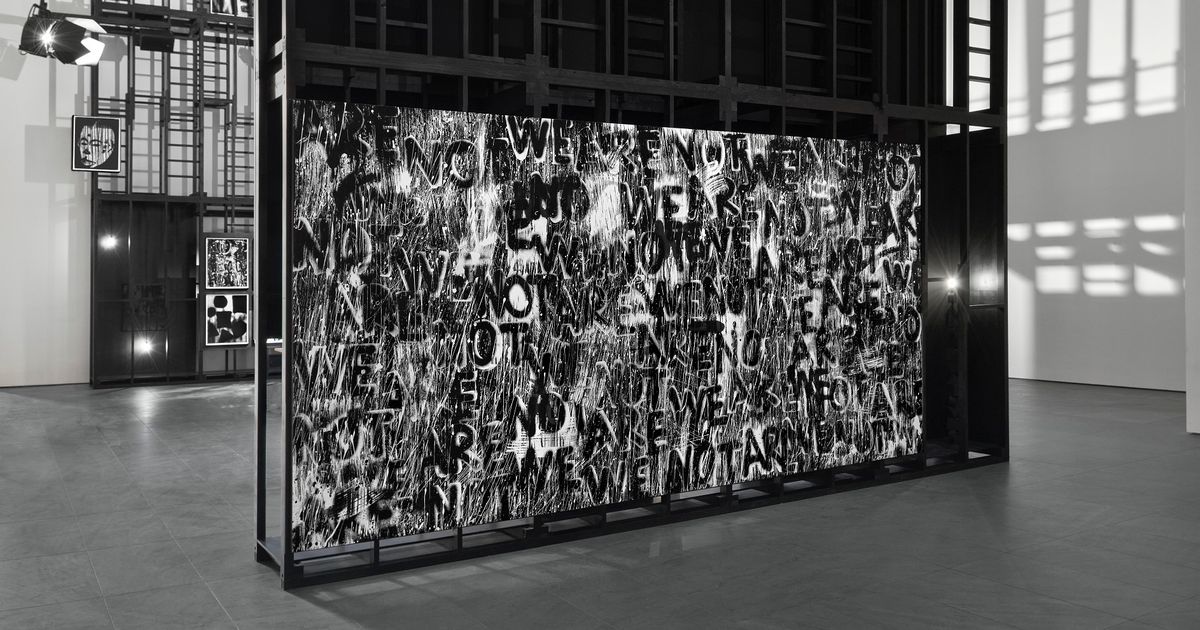 Adam Pendleton: Who is Queen?
Adam Pendleton: Who is Queen?
Until 30 January 2022 at the Museum of Modern Art, 11 West 53rd Street, Manhattan
The American artist Adam Pendleton, who creates referential mixed-media installations that explore themes around Black activism and the avant-garde, describes his works as “Black Dada”. The artist has engulfed MoMA’s atrium with an installation comprising three towering scaffold sculptures that are affixed at various levels with canvases showing scrambled and repeated text, evoking the graffiti that covered racist monuments and memorials nationwide during the Black Lives Matter protests. A series of videos projected onto a colossal screen amalgamate some of the polarising and triumphant moments of the past year—including images of the last-standing statue of the Confederate general Robert E. Lee in Richmond, Virginia, which was removed from its pedestal earlier this month—and also honour Black figures like the queer theorist Jack Halberstam. The cacophonous space is flooded with an audio collage that interweaves the voice of the late poet Amiri Baraka with music. The commission is Pendleton’s first solo presentation in a US institution, celebrating the rising star and his ability to poetically convey timely and historical issues through highly conceptual works.
Objects of Common Interest: Hard, Soft, and All Lit Up with Nowhere to Go
Until February 13, 2022, The Isamu Noguchi Foundation and Garden Museum, 9-01 33rd Road (at Vernon Boulevard), Long Island City, Queens
The design duo Eleni Petaloti and Leonidas Trampoukis, who split their time between Greece and New York, used to visit the Noguchi Museum, tucked away in a northern corner of Queens, when they were architecture students at Columbia University. Now, the playful, minimalist lamps, furniture and design pieces they create through their Brooklyn studio Objects of Common Interest find a common language with the Japanese sculptor’s work in an exhibition open by appointment. Petaloti and Trampoukis share a sensibility with Noguchi of breaking down the rigid forms and functions of art “at the DNA level”, says Dakin Hart, the museum’s senior curator. This can especially be seen in the installation in the sculpture garden, where opalescent acrylic “stones” made using a specially formulated secret process sit comfortably among Noguchi’s own Practice Rocks, and a 10ft-tall inflatable obelisk floats happily next to the sculptor’s hovering monoliths. Noguchi’s ties to Greece, which he called his “intellectual home”, and its long artistic history are also evident throughout the show, including in an online “visual collage” called Noguchi in Greece, Greece Within Noguchi, and a set of books Objects of Common Interest are working on that expands on the project.
 Paul Thek: Relativity Clock
Paul Thek: Relativity Clock
Until 16 October at Alexander and Bonin, 47 Walker Street, Manhattan
The exhibition serves as a mini-survey of Paul Thek’s work, with pieces from as early as 1966 through to 1988, the year of his death. As we see here and across the prolific artist’s wider oeuvre, no medium was off limits for him, perhaps because, like so many great artists, there was no barrier between Thek and his practice, granting an immediacy to his work that cannot be faked. There is a sculpture on view from his Technological Reliquaries series of uncanny, fleshy forms encased in plexiglass vitrines; there are landscape drawings and watercolours from his time abroad, as well as the consistently heartbreaking paintings from his final years following his return to New York. A number of these late paintings were done on newspaper and displayed at the eye-level of a small child, with a toddler-sized school chair placed in front of them. Though he had a complicated relationship to religion, Thek was a devout Catholic—he made multiple unsuccessful attempts to join a monastery—and as Aids was sewing mortality into the fabric of his consciousness (his own diagnoses came in 1987), his work was simultaneously entering this odd, childlike realm. After all, it was Christ who said: “Unless you turn and become like children, you will never enter the kingdom of heaven”.
Source link : https://www.theartnewspaper.com/review/three-exhibitions-to-see-in-new-york-this-weekend-17-september












